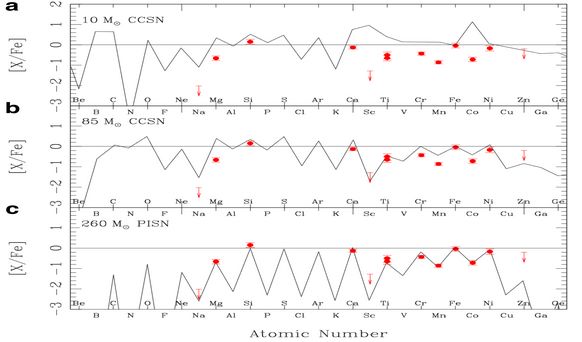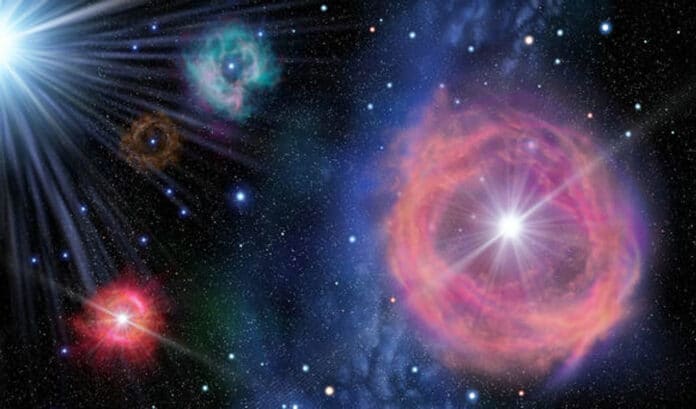The most massive and shortest-lived stars dominate the chemical evolution of the pre-galactic era. Based on numerical simulations, it has long been speculated that the mass of such first-generation stars was up to several hundred solar masses.
Among them, the first stars with masses between 140 and 260 solar masses became pair-instability supernovae (PISNe). PISNe are quite different from ordinary supernovae and would have imprinted a unique chemical signature in the atmosphere of the next-generation stars.
In a new study, scientists identified a chemically peculiar star (LAMOST J1010+2358) in the Galactic halo as clear evidence of the existence of PISNe from very massive first stars in the early Universe. They used the Large Sky Area Multi-Object Fiber Spectroscopic Telescope (LAMOST) survey and follow-up high-resolution spectra observation by Subaru Telescope.
It has been confirmed that this star was formed in the gas cloud dominated by the yields of a PISN with 260 solar masses.
The study team used the Subaru telescope to conduct further high-resolution spectroscopic observations of J1010+2358 and obtain abundances for more than ten elements. This star’s extraordinarily low sodium and cobalt abundances are its most noteworthy characteristic. It has a sodium-to-iron ratio less than 1/100 that of the sun. The abundance of elements with odd and even charge numbers, such as sodium/magnesium and cobalt/nickel, varies greatly in this star.
This star’s unique odd-even variance and sodium and -elements deficiencies align with the primordial PISN prediction made by first-generation stars with 260 solar masses.

The finding of J1010+2358 provides concrete evidence for the hydrodynamical instability attributed to the formation of electron-positron pairs in the theory of developing very massive stars. A huge star’s core experiences a partial collapse due to the formation of electron-positron couples, which lowers the thermal pressure there.
Prof. ZHAO Gang, a corresponding author of the study, said, “It provides an essential clue to constraining the initial mass function in the early Universe. Before this study, no evidence of supernovae from such massive stars has been found in the metal-poor stars.”
Additionally, LAMOST J1010+2358 has a substantially greater iron abundance ([Fe/H] = -2.42) than the majority of metal-poor stars in the Galactic halo, indicating that second-generation stars created in the PISN-dominated gas may be more metal-rich than anticipated.
Prof. Avi Loeb, former chair of the Astronomy Department at Harvard University, said, “One of the holy grails of searching for metal-poor stars is to find evidence for these early pair-instability supernovae.”
Prof. Timothy Beers, the provost’s chair of astrophysics at Notre Dame University, commented on the results: “This paper presents what is, to my knowledge, the first definitive association of a Galactic halo star with an abundance pattern originating from a PISN.”
Journal Reference:
- Xing, QF., Zhao, G., Liu, ZW. et al. A metal-poor star with abundances from a pair-instability supernova. Nature (2023). DOI: 10.1038/s41586-023-06028-1
